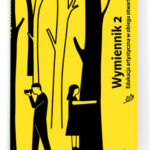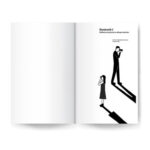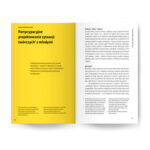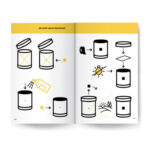Books
‘Wymiennik 2’ (Interchanger 2) – the second part of the bestselling guide to art in education
Editor Aneta Zasucha encourages you to look inside and put the content into practice:
What is creativity? Contemporary psychology treats it as a multidimensional and ambiguous phenomenon that constitutes an important and interesting subject of scientific research. Many disciplines – including pedagogy, anthropology, cognitive science and philosophy – attempt to define creativity by considering it from a subjective perspective.
I’m an advocate of the theory of the egalitarian nature of creativity, and I am close to the concepts of humanistic psychology (e.g. Carl Rogers and Abraham Maslow), which state that everyone is creative, although not to the same extent. Creativity, in such a view, is treated as one of many human characteristics (alongside, for example, intelligence), as an inherent attribute of human nature. Maslow introduced the concept of self-actualized creativity, according to which a person who continuously develops, accepts himself or herself and experiences reality in an extraordinary way, deserves to be called a creative person. Self-actualization therefore has a creative dimension by its very nature, because a person who develops the possibilities inherent in him or herself is creative – precisely because the process of self-actualization is by definition creative.
Unfortunately, not all people can fully use their creative potential. There are many obstacles that limit its development. These are often due to social and/or emotional conditioning or purely cognitive barriers. As an art educator and art therapist, I firmly believe that art is a tool through which these barriers can not only be removed but also creative activity can be stimulated, supporting and developing creative potential.
We created this publication with you in mind. If you are reaching for it, it means that you are a very creative person – you are learning, looking for new challenges, getting inspired, improving your working methods. This publication is the result of meetings with great artists, educators, animators and pedagogues. It is a platform for exchange that puts out into the open valuable practices and methods which can become an inspiration for improving our educational and artistic work, for experiencing art and for self-development.
Table of Contents (sorry, in Polish only)
Aneta Zasucha Jak edukować poprzez sztukę współczesną
Poznajmy się – ćwiczenia twórcze rozpoczynające spotkanie
Przykłady ćwiczeń aktywizujących twórcze myślenie
Przykłady ćwiczeń z wykorzystaniem dzieła sztuki
Jolanta Jastrząb Sztuka w działaniu
Życie
Agata Hofelmajer-Roś Partycypacyjne projektowanie sytuacji twórczych z młodymi
Muzyka optyczna
Nowe legendy miejskie
Świetlica sztuki
Elżbieta Sala-Hołubowicz Włączająca edukacja kulturowa jako receptywna relacja
Alicja Bielawska W przepływie
Michał Smandek Akcje rysunkowe
Natalia Gołubowska m jak miasto. m jak mediatorka. m jak mapa.
Wspólnie przy zieleni
Jestem, jaki? Jestem. Zmapuj siebie
Matylda Sałajewska Znak równości
Oswajanie
Diana RÖnnberg Hybrydy
Olga Ślepowrońska Mapa ciała
Wstyd
Zuzanna Sokołowska Edukowanie poprzez zapach. Praktyki olfaktoryczne jako element twórczego rozwoju
Michalina Bigaj Ćwiczenia zapachowe
Kamil Myszkowski i Krzysztof Szlapa gra warta świeczki
Aparat z pudełka po butach
Aparat otworkowy (kamera obscura)
Anna Nowak Teatr i zabawa
Przykłady ćwiczeń
Agnieszka Batóg, Dominika Kobiela
Miękkie kompetencje dla życiowych twardzieli. Rozwój umiejętności społecznych u młodzieży poprzez wykorzystanie technik scenicznych
Gra improwizacyjna
Joanna Bronisławska Słuchaj siebie!
Anna Nacher Popołudniowa herbata a kryzys ekologiczny – sztuka/nauka w świecie społecznym
Marek Styczyński Sztuka (w) edukacji ekologicznej
Scenariusz w oparciu o sztukę współczesną (wiosna, lato)
Scenariusz (zima, późna jesień)
Aneta Zasucha Leśne kąpiele
Ewa Baranowska-Jojko Jesteśmy ze sobą połączeni
Alicja i Agata Kloczkowskie Ćwiczenia komorebi
Biogramy
publisher: BWA Contemporary Art Gallery
editing: Aneta Zasucha
year of publication: 2022
size: 144 × 216 mm
256 pages
edition: 500 pieces
cover: softcover with hinged jacket
duotone reproductions
Polish language
graphic design: Jan Piechota
typesetting, illustrations: Magdalena Niglus
ISBN 978-83-66006-17-1
Visit the bookstore!
Order a book!





